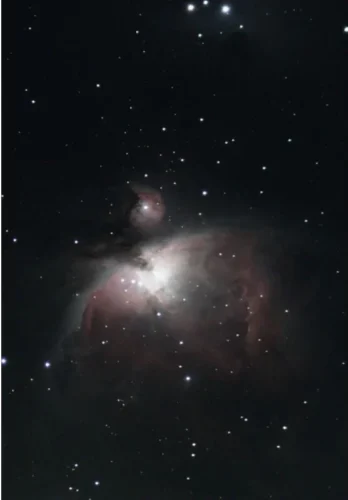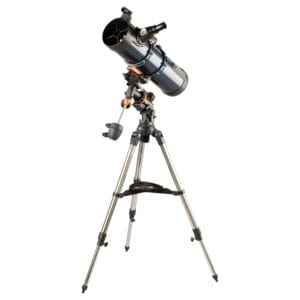We frequently get asked: DWARF 3 vs Seestar S50, which should we choose?
The smart telescope market is evolving. Two popular models for both beginner and advanced astrophotographers are the DWARF 3 by DwarfLab and the Seestar S50 by ZWO. In this comparison, you’ll discover the technical differences, user experience, and performance in photographing the sun, moon, and deep-sky objects like the Andromeda Galaxy.
DWARF 3 vs Seestar S50: Price and Accessories
The DWARF 3 costs about €650 with tripod. The Seestar S50 about €719.
- The DWARF 3 comes without a tripod but includes a carrying case, solar filters, and a 10,000 mAh battery.
- The Seestar S50 includes a tripod, solar filter, carrying case, 6,000 mAh battery, and 64 GB storage.
✔ DWARF 3 offers more storage (128 GB) and longer battery life.
✔ Seestar is more complete out of the box thanks to the included tripod.
DWARF 3 vs Seestar S50: Optics and Sensor
- DWARF 3: 35 mm telephoto lens, 8.3 MP Sony IMX678 sensor with Starvis 2, image scale 2.75″/pixel
- Seestar S50: 250 mm telephoto lens, 2 MP Sony IMX462 sensor, image scale 2.39″/pixel
The DWARF 3 offers a wider field of view (2.93° x 1.65°), ideal for large objects like M31. The Seestar S50 delivers slightly sharper details on smaller objects due to its longer focal length.
✔ DWARF 3 is suitable for wide nebulae and galaxies.
✔ Seestar S50 is more powerful in magnification and detail-level sharpness.
Solar Photography
Both models deliver good images of sunspots thanks to the included solar filters.
- The DWARF 3 makes it easier with its magnetic solar filter and direct image control.
- The Seestar S50 offers good autofocus and has slightly better brightness and contrast on sunspots.
✔ Seestar S50 wins on brightness
✔ DWARF 3 wins on ease of use and flexibility
Moon Observation
Both telescopes deliver beautiful, stacked images of the moon.
- The Seestar S50 had slightly more detail thanks to larger lens aperture.
- The DWARF 3 offers automatic tracking, live stacking, and more flexibility in settings.
✔ Seestar S50 is slightly sharper on crater details
✔ DWARF 3 is more versatile for stacking and editing
Deep-sky Astrophotography
Here the difference becomes clear:
- The DWARF 3 features an EQ mode for polar alignment, allowing exposures up to 60 seconds without field rotation.
- The Seestar S50 has no polar alignment and is limited to 10-30 second exposures → more prone to field rotation during long sessions.
The DWARF 3 delivered better results on the Andromeda Galaxy, Heart Nebula, and M45, as the longer exposure time reveals more nebula structure.
The Seestar S50, however, showed sharper stars with shorter exposures, which is useful in urban areas with light pollution.
✔ DWARF 3 is superior for large nebulae, star clusters, and complete galaxy structures
✔ Seestar S50 is better for compact objects with short exposures
User Experience and Apps
- DWARF 3: advanced app with joystick control, Astro mode, filters, and EQ tracking. Steeper learning curve but more control.
- Seestar S50: extremely user-friendly, fully automated, perfect for beginners. More limited in advanced features.
✔ DWARF 3 is more powerful if you want to learn and tweak
✔ Seestar S50 is more intuitive for quick results
Filters, Formats, and Storage
Both telescopes are equipped with useful built-in filters for astrophotography in light-polluted environments. The DWARF 3 offers multiple adjustable filters: a VIS filter for daytime use, an Astro filter for night use, and a Dual-band filter for emission nebulae like the Heart and Veil Nebula. The Seestar S50 also includes a standard internal Dual-band filter, which is essential for isolating hydrogen and oxygen emissions in deep-sky objects.
Regarding storage, the DWARF 3 with 128 GB has a clear advantage over the Seestar S50’s 64 GB. Both models support RAW formats like FITS and AVI, and offer live stacking, but the DWARF 3 also allows manual processing of individual frames – giving advanced photographers more control over image quality.
✔ DWARF 3 is better suited for those who want to maximize image quality with manual post-processing
✔ Seestar S50 offers sufficient storage and filter options for automatic astrophotos
Conclusion: DWARF 3 vs Seestar S50
| Aspect | Winner |
|---|---|
| Wide-angle & broad objects | DWARF 3 |
| Detail & sharpness | Seestar S50 |
| Battery & storage | DWARF 3 |
| Ease of use | Seestar S50 |
| Astrophotography potential | DWARF 3 |
| Suitable for beginners | Both |
The Seestar S50 is ideal for those who want quick beautiful results without technical settings.
The DWARF 3 is perfect for those who want to go a step further, including EQ tracking, deeper control, and wider celestial objects.








